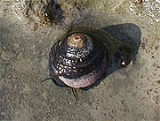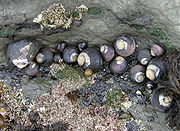
Black Turban Snail
Encyclopedia
The black turban snail, scientific name Tegula funebralis, is a species
of medium-sized sea snail
with gill
s and an operculum
, a marine
gastropod
mollusc
in the family Turbinidae
.
This is an Eastern Pacific Ocean
species.
of North America
from Vancouver Island
to the central part of the Baja California peninsula
in Mexico.
which are 20 to 40 mm (or about an inch, to an inch and three quarters) in diameter.
Empty shells of this species are very often used by hermit crab
s, especially Pagurus samuelis
.
In 1971 a new sense organ was discovered in this marine snail. Chemoreceptor organs were found near the base on the border of the leaflets of the ctenidium (comb-like respiratory gills), one on each leaflet. They form a light swelling near the base of the leaflet with a pocket lying within the swelling. Together they are termed a "bursicle".


, where these snails graze on algae
, microscopic films, and wrack. Small juveniles are found mostly under rocks and among coarse sands.
, not hermaphroditic
. These snails may live as long as twenty or thirty years.
When fleeing a predator on a sloping substrate, the snail may simply detach itself and thus it will roll or drop away.
s, and predatory starfish
such as Pisaster ochraceous.
peoples.
Species
In biology, a species is one of the basic units of biological classification and a taxonomic rank. A species is often defined as a group of organisms capable of interbreeding and producing fertile offspring. While in many cases this definition is adequate, more precise or differing measures are...
of medium-sized sea snail
Snail
Snail is a common name applied to most of the members of the molluscan class Gastropoda that have coiled shells in the adult stage. When the word is used in its most general sense, it includes sea snails, land snails and freshwater snails. The word snail without any qualifier is however more often...
with gill
Gill
A gill is a respiratory organ found in many aquatic organisms that extracts dissolved oxygen from water, afterward excreting carbon dioxide. The gills of some species such as hermit crabs have adapted to allow respiration on land provided they are kept moist...
s and an operculum
Operculum (gastropod)
The operculum, meaning little lid, is a corneous or calcareous anatomical structure which exists in many groups of sea snails and freshwater snails, and also in a few groups of land snails...
, a marine
Marine (ocean)
Marine is an umbrella term. As an adjective it is usually applicable to things relating to the sea or ocean, such as marine biology, marine ecology and marine geology...
gastropod
Gastropoda
The Gastropoda or gastropods, more commonly known as snails and slugs, are a large taxonomic class within the phylum Mollusca. The class Gastropoda includes snails and slugs of all kinds and all sizes from microscopic to quite large...
mollusc
Mollusca
The Mollusca , common name molluscs or mollusksSpelled mollusks in the USA, see reasons given in Rosenberg's ; for the spelling mollusc see the reasons given by , is a large phylum of invertebrate animals. There are around 85,000 recognized extant species of molluscs. Mollusca is the largest...
in the family Turbinidae
Turbinidae
Turbinidae, the turban snails, are a family of small to large marine gastropods. Turbinidae have a strong, thick calcareous operculum readily distinguishing them from the somewhat similar Trochidae or top snails, which have a corneous operculum...
.
This is an Eastern Pacific Ocean
Pacific Ocean
The Pacific Ocean is the largest of the Earth's oceanic divisions. It extends from the Arctic in the north to the Southern Ocean in the south, bounded by Asia and Australia in the west, and the Americas in the east.At 165.2 million square kilometres in area, this largest division of the World...
species.
Distribution
The species is found along the Pacific coastPacific Coast
A country's Pacific coast is the part of its coast bordering the Pacific Ocean.-The Americas:Countries on the western side of the Americas have a Pacific coast as their western border.* Geography of Canada* Geography of Chile* Geography of Colombia...
of North America
North America
North America is a continent wholly within the Northern Hemisphere and almost wholly within the Western Hemisphere. It is also considered a northern subcontinent of the Americas...
from Vancouver Island
Vancouver Island
Vancouver Island is a large island in British Columbia, Canada. It is one of several North American locations named after George Vancouver, the British Royal Navy officer who explored the Pacific Northwest coast of North America between 1791 and 1794...
to the central part of the Baja California peninsula
Baja California Peninsula
The Baja California peninsula , is a peninsula in northwestern Mexico. Its land mass separates the Pacific Ocean from the Gulf of California. The Peninsula extends from Mexicali, Baja California in the north to Cabo San Lucas, Baja California Sur in the south.The total area of the Baja California...
in Mexico.
Description
Most adult individuals of this species have shellsExoskeleton
An exoskeleton is the external skeleton that supports and protects an animal's body, in contrast to the internal skeleton of, for example, a human. In popular usage, some of the larger kinds of exoskeletons are known as "shells". Examples of exoskeleton animals include insects such as grasshoppers...
which are 20 to 40 mm (or about an inch, to an inch and three quarters) in diameter.
Empty shells of this species are very often used by hermit crab
Hermit crab
Hermit crabs are decapod crustaceans of the superfamily Paguroidea. Most of the 1100 species possess an asymmetrical abdomen which is concealed in an empty gastropod shell that is carried around by the hermit crab.-Description:...
s, especially Pagurus samuelis
Pagurus samuelis
Pagurus samuelis, the blueband hermit crab, is a species of hermit crab from the west coast of North America, and the most common hermit crab in California. It is a small species, with distinctive blue bands on its legs...
.
In 1971 a new sense organ was discovered in this marine snail. Chemoreceptor organs were found near the base on the border of the leaflets of the ctenidium (comb-like respiratory gills), one on each leaflet. They form a light swelling near the base of the leaflet with a pocket lying within the swelling. Together they are termed a "bursicle".
Ecology


Habitat
The species is found in the rocky intertidal zoneIntertidal zone
The intertidal zone is the area that is above water at low tide and under water at high tide . This area can include many different types of habitats, with many types of animals like starfish, sea urchins, and some species of coral...
, where these snails graze on algae
Algae
Algae are a large and diverse group of simple, typically autotrophic organisms, ranging from unicellular to multicellular forms, such as the giant kelps that grow to 65 meters in length. They are photosynthetic like plants, and "simple" because their tissues are not organized into the many...
, microscopic films, and wrack. Small juveniles are found mostly under rocks and among coarse sands.
Life habits
Tegula funebralis is sexually dimorphicSexual dimorphism
Sexual dimorphism is a phenotypic difference between males and females of the same species. Examples of such differences include differences in morphology, ornamentation, and behavior.-Examples:-Ornamentation / coloration:...
, not hermaphroditic
Hermaphrodite
In biology, a hermaphrodite is an organism that has reproductive organs normally associated with both male and female sexes.Many taxonomic groups of animals do not have separate sexes. In these groups, hermaphroditism is a normal condition, enabling a form of sexual reproduction in which both...
. These snails may live as long as twenty or thirty years.
When fleeing a predator on a sloping substrate, the snail may simply detach itself and thus it will roll or drop away.
Predators
Predators of Tegula funebralis include sea otterSea Otter
The sea otter is a marine mammal native to the coasts of the northern and eastern North Pacific Ocean. Adult sea otters typically weigh between 14 and 45 kg , making them the heaviest members of the weasel family, but among the smallest marine mammals...
s, and predatory starfish
Sea star
Starfish or sea stars are echinoderms belonging to the class Asteroidea. The names "starfish" and "sea star" essentially refer to members of the class Asteroidea...
such as Pisaster ochraceous.
Human use
The black turban snail was harvested in the Early Period by the Native AmericanNative Americans in the United States
Native Americans in the United States are the indigenous peoples in North America within the boundaries of the present-day continental United States, parts of Alaska, and the island state of Hawaii. They are composed of numerous, distinct tribes, states, and ethnic groups, many of which survive as...
peoples.

